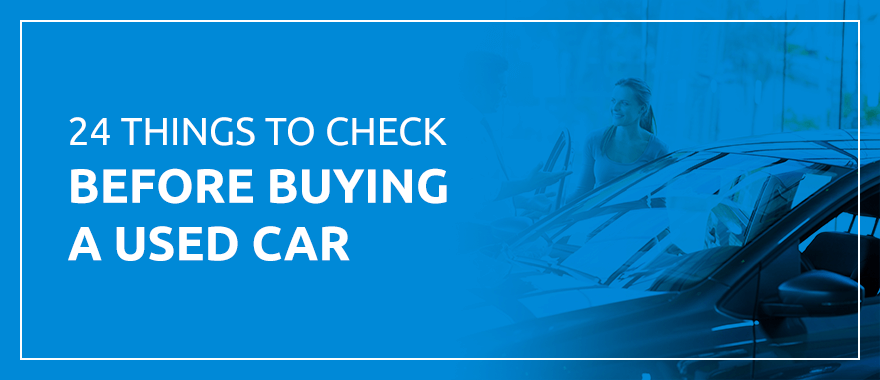
In 2020, over 39 million used light vehicles sold in the United States, nearly three times the number of new vehicles sold that year. For many buyers, used cars can be a great investment. The lower price tag and potentially reduced premium make used vehicles a better value, which can be incredibly appealing for car shoppers.
Yet buyers in the market for a used car still need to exercise caution when shopping. These vehicles need special attention to ensure their safety and prevent unpleasant surprises.
Review our recommendations on what to check when buying a used car so you can ensure you get the most out of your used car.
The most important point to remember is that your buying-a-used-car checklist should be systematic and detailed. Taking your time to get to know a used car can help you find one in good condition that can hopefully last you a long time.
Going through a pre-inspection process is necessary to know the car’s history and reveal potential issues that might surface. Before you arrange a test drive, obtain the following details:
Obtaining a vehicle’s history report is one of the most critical steps in buying a used car. A vehicle history report lists the car’s previous owners, repairs, accidents, odometer readings and open recalls.
Historical information about a vehicle can reveal hidden costs. For example, a car with a history of several accidents might require more extensive upkeep later.
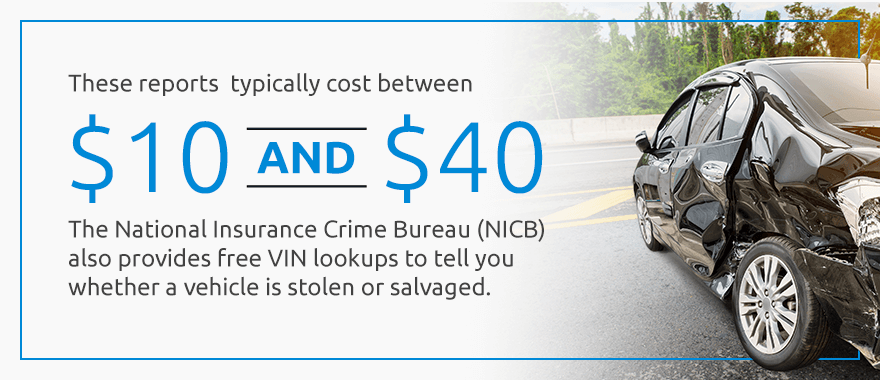
To get a copy of a car’s vehicle history, you can ask the seller or use the car’s vehicle information number (VIN) to find a copy online through a trusted website. These reports typically cost between $10 and $40. The National Insurance Crime Bureau (NICB) also provides free VIN lookups to tell you whether a vehicle is stolen or salvaged.
Each vehicle has a unique VIN, a 17-digit number located on the bottom left of the windshield. You can also find the VIN on the car’s registration card and insurance documents. Use the VIN to determine whether the vehicle or its parts have been recalled on the National Highway Traffic Safety Administration’s (NHTSA) safety recalls page.
You can also use the VIN to check if the information matches the vehicle’s title and records. The NHTSA has a free online VIN decoder that interprets a car’s VIN for you.
The car’s title should be clear, meaning that it isn’t salvaged or branded. A branded title indicates that a vehicle has experienced extensive damage or had another defect that caused the manufacturer to repurchase it. These cars were repaired or rebuilt before being put back on the market, but you may struggle to get insurance for a vehicle with a branded title.
If you’re buying a car directly from an individual seller, ensure they have the used car’s title when you purchase. You need to carefully document the transfer of ownership to ensure you aren’t held liable for any debt the seller still owes on the car.
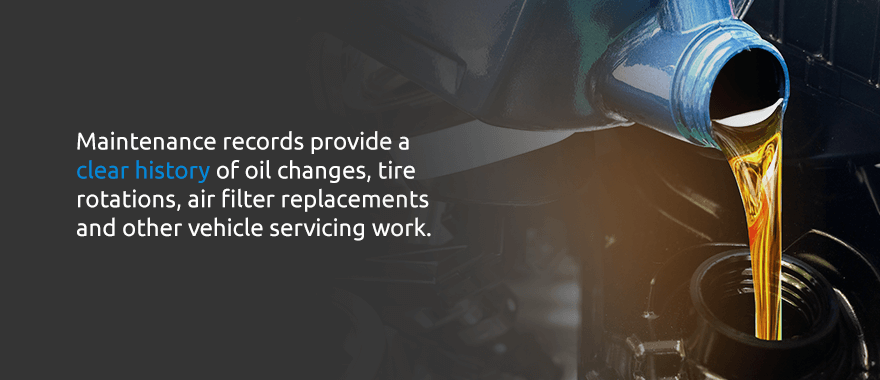
Knowing the routine maintenance on a car can help you decide whether to commit or walk away. Maintenance records provide a clear history of oil changes, tire rotations, air filter replacements and other vehicle servicing work. Completing these routine repairs on time keeps the car’s engine in better long-term condition.
Maintenance records will also describe the car’s current mechanical and electrical state and whether the vehicle is due for further servicing. The mileage could indicate that the next owner will have to service the transmission, flush the brake fluid or perform related services.
There might not be much to worry about if the mileage is consistent with the car’s year. Lower mileage can be appealing, as buyers associate it with a vehicle that hasn’t seen much wear.
However, low mileage might indicate that the car sat in a garage most of the time. Lack of use can lead to dry rotting tires and other deterioration. You might need to ask further questions if the car’s mileage is less than 8,000 per year or more than 20,000 per year.
Remember that the car’s routine maintenance and repairs indicate more about its condition than its odometer.
Only a car’s valid owner is legally allowed to sell it. Buying a used car from someone who doesn’t own it can land you in a tricky situation. For example, if the seller owes money on the vehicle to a third-party lender, they can’t sell it to you without the lender’s permission.
Ask the seller if their name is on the title. The sale is only binding if the name of the person selling the car matches the one listed on the title or registration.
This shouldn’t be an issue when you’re buying a used car from a dealership, as the dealership now owns that car, but it never hurts to double-check.
Next on your used car checklist is the exterior inspection. You’ll want to set up a time to examine the car so you can take note of any changes you might need to make. With careful attention to detail, you can often tell whether the vehicle has been in any accidents, how well it’s been maintained and where it’s usually parked.
Take your time during your inspection and write down anything you might need to ask the seller about later. Pay attention to features like:
The condition of a car’s tires tells you a lot about its road safety. A car’s tires are always on the pavement, so safe wheels are essential. When you complete your tire inspection, look for the following features:
Check each body panel and the roof, looking for dents and misalignment. The condition of the panels can tell you more about the car’s accident history. While small indentations usually only indicate simple surface-level damage, larger damaged areas could be a reason to worry.
Ensure that the body panels line up evenly. Panels that are misaligned could indicate poor repairs after an accident or shabby manufacturing, which is still a reason to ask further questions and possibly have a mechanic inspect the vehicle.
Buyers in the used car market can’t always be picky about the paint color of their next vehicle. However, a car’s paint condition reveals how past owners have maintained it.
Paint swirls, wears and scratches as it ages, but significant differences are a red flag. The paint on each body panel should be consistent. A body panel painted a completely different color than the rest of the car was likely replaced after a significant accident. Check for paint overspray under the doors and inside the hood that indicates the owner had to repaint the body.
Rust is another potential problem on a car’s exterior. A vehicle with a lot of rust could be structurally unsound. Walk around the car, checking for areas of rust. Blistered or chipped paint also indicates a spot that could develop rust later.
Expect some rust on an older car. Smaller patches aren’t a big concern, but large spots might need repairing later. Extensive rust around the exhaust pipe could also mean you need to replace the car’s exhaust system.
Check close to the bottom of the vehicle, beneath the doors and around the windshields for rust.
If a car is leaking any fluid, it’s time for repairs. Look beneath the vehicle, especially toward the front, to see if any fluid is leaking onto the ground. Different colored fluids indicate various problems:
Frame issues like bending and warping are signs of a recent accident or damage from an accident that the owner didn’t repair. Extensive frame damage can lead to a vehicle being salvaged since the car’s parts won’t work together correctly. Fixing this kind of damage could cost tens of thousands of dollars.
Frame issues are typically easy to spot. Note whether the car sits low to the ground and examine its undercarriage. Look at the hood, trunk and bumpers for signs of warping. The cost of fixing structural problems with the frame could outweigh what the car is ultimately worth.
If you’re unfamiliar with car engines, under the hood might be an intimidating place. However, checking for issues can save you a considerable investment later. The car’s engine is its most vital part and one you certainly want to be in good condition.
Follow these steps when the engine is cool:
Inspect the car’s lights before you go for the test drive. Turn on the vehicle and have a friend tell you whether the exterior bulbs function. Check for rear and brake lights, as well.
Plastic light housings will typically fade with time. The previous owner likely replaced mismatched headlamps, tail lamps or housings. Ensure the housings are intact and not missing, fogged with condensation or cracked. If headlamps are extremely cloudy or yellowed, the car has been out in the sun a long time, which means the paint, trim and tires could all be affected by the exposure.
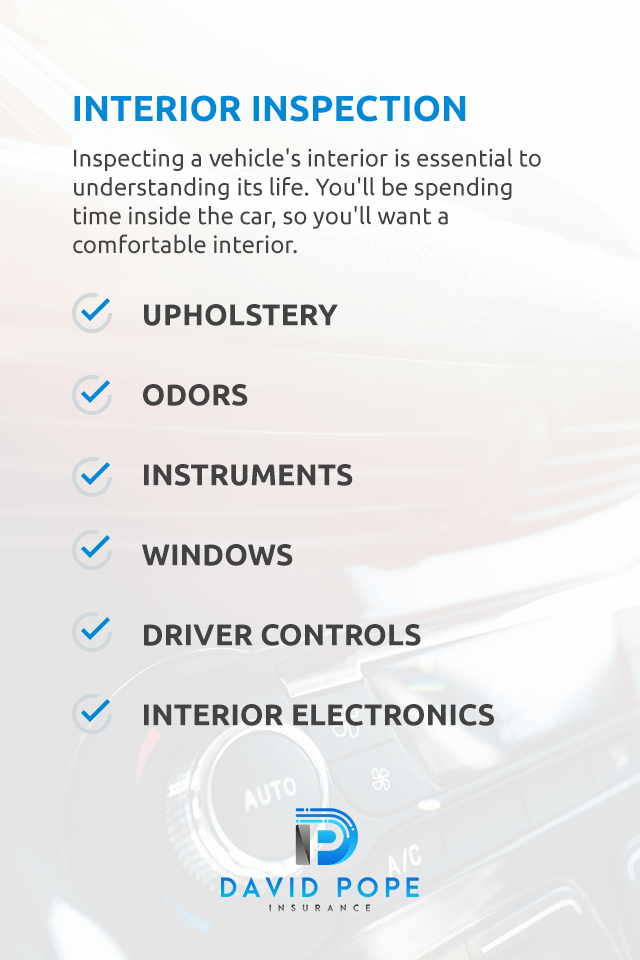
Inspecting a vehicle’s interior is essential to understanding its life. You’ll be spending time inside the car, so you’ll want a comfortable interior.
The wear and tear, smell and general features of a car’s interior can impact whether you decide to buy it. Look out for minor issues you can solve quickly and other considerations that could be more of an investment.
The wear and tear on upholstery should be consistent with the car’s mileage. You’ll want to look for seats that have minimal rips and holes.
Here are a few things to check when inspecting the seats:
You can clean minor stains and crumbs, but they also indicate how the car has been treated, so it’s important to take them as a sign of how the previous owner cared for the vehicle.
Many odors will dissipate with time or can be eliminated with ozone treatment. However, tobacco smoke could be nearly impossible to remove.
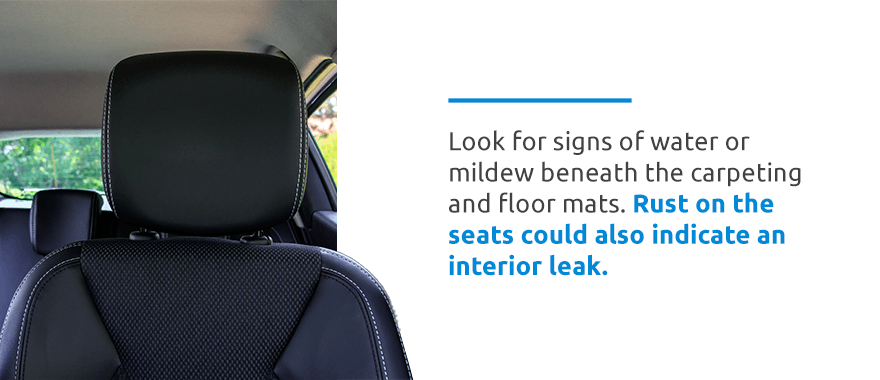
If the vehicle smells musty or mildewy, it might have water damage. Look for signs of water or mildew beneath the carpeting and floor mats. Rust on the seats could also indicate an interior leak. It’s best to pass on the car if you find water collected on the floor or in the spare tire well.
Examining the instrument panel will help you determine significant issues with the car’s essential functions. Non-functioning instrument bulbs might not mean something is wrong with the vehicle, but replacing them is an expensive upgrade.
Follow these five steps when checking the instrument cluster:
A car’s windows are a vital safety feature. Check each window carefully for hairline cracks and signs of damage. Minor chips aren’t a cause for concern, although you can certainly mention them in price negotiations. However, you will need to replace windows with large cracks. Repairs like these can be costly.
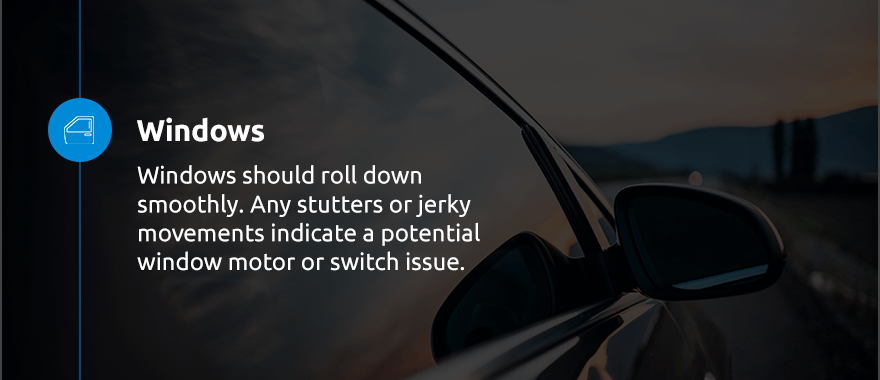
It’s also a good idea to open and close all of the windows and doors to see if they stick or hang loose. Windows should roll down smoothly. Any stutters or jerky movements indicate a potential window motor or switch issue.
Modern cars come with conveniences like steering wheel audio control and cruise control. Ask the seller what kinds of features are included and then test each one:
A faulty cruise control button or malfunctioning horn could mean you have to make a costly repair. They could also be serious dangers, so you want to be aware of them before you sign the dotted line.
One of the joys of car ownership is playing your favorite music and singing along while you drive. Check the sound system while the car idles and see if it gets good reception for FM, AM and satellite radio. If the vehicle has a CD player, pop one in to test the sound. Newer models might also have Bluetooth capabilities, so see if your phone connects.
There’s nothing like a good heating, ventilation and air conditioning (HVAC) system to keep you comfortable in the hot summer. While the car idles, turn on the heating and air conditioning. Note how long each option takes to begin operating fully.
The most exciting part of buying a car is the test drive. Plan out your route to take the vehicle over various road conditions and test its ability to handle train tracks, roundabouts, highways and parallel parking. It’s essential to understand how the car behaves at different speeds and on various roads.
There might be an issue you discover on a drive that you wouldn’t have noticed before. Paying careful attention during your test drive can save you a lot of headaches post-purchase.
Working brakes are a crucial element to any car. First, look for worn rubber on the brake pedal. A high amount of wear probably indicates that the previous owner was hard on the brake system, so stay alert to potential issues.
You’ll want to get a feel for the brakes early on in your drive. Slowly pressing the brake pedal to the floor should bring the car to a smooth stop. Shaking during braking could be a sign of warped rotors.
A car’s steering shows you its maneuverability and how it handles. Before pulling onto the road, turn the steering wheel to the right and left to check for power steering. Watch out if the wheel sticks or turns stiffly.
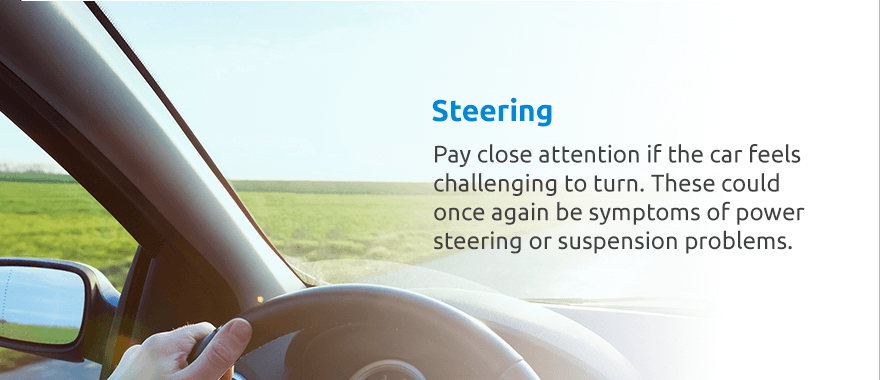
Take right and left turns at various degrees to see how quickly the steering responds. Steering should be consistent and always return to the center. Pay close attention if the car feels challenging to turn. These could once again be symptoms of power steering or suspension problems.
Get a good feel for the car’s power. Press on the gas on a straight road and see how quickly you can accelerate while remaining legal and safe.
Taking the car onto the highway shows you how easy it is to merge with and pass other drivers. If the car hesitates or shows warning lights when you drive aggressively on the interstate, you might need to do some tuning-up.
Any abnormal noises or shaking while driving are cause for concern. Keep your ears open and pay attention to braking noises like grinding or squealing. These sounds could indicate worn brake pads or rusted rotors.
Other unusual sounds during acceleration or turning could include red flags like rattling, grinding, squealing and clunking noises. You could be looking at repairs for loose steering parts or faulty suspension.
Finding a used car in excellent condition that fits your needs can be challenging, but the time and effort are worth the benefits of added safety and being able to drive your vehicle for years to come.
Here are a few last tips for the used car buying process so you can make the best decision possible:
A certified pre-owned (CPO) vehicle provides guaranteed quality. CPO vehicles add more quality assurance since they have to go through an inspection and meet certain standards. Although the specific requirements vary by manufacturer, CPO cars typically have less than 65,000 miles and are less than five years old.
With a CPO car, you get the benefits of:
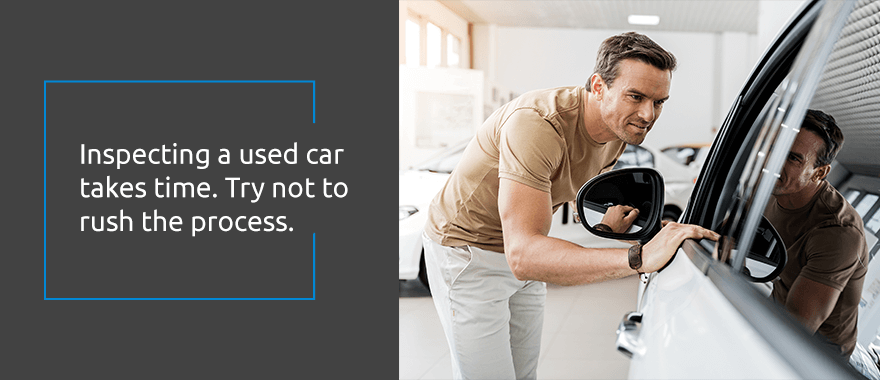
Inspecting a used car takes time. Try not to rush the process. Going too quickly through your used car checklist could make you overlook important issues that you might not want to handle later.
Take time researching your options, gathering information and performing your vehicle inspection. You want to be sure you’re buying a car you like that will keep you safe while you drive and not cost more than you’re willing to invest in it.
Be patient when determining a fair price, too. You shouldn’t feel pressured into buying the first car you look at because its price seems low or paying for a more expensive vehicle just because of the dealer.
To ensure you pay a fair price for your used car, compare other vehicles of similar year, make and model. Look at multiple sources to determine if one seller is overcharging. Online resources can help you get a broad idea of a car’s market value.
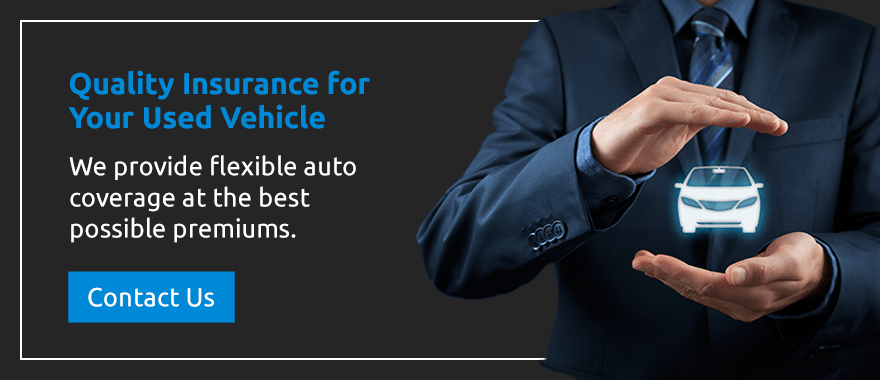
If you need insurance for your used car, partner with David Pope Insurance Services, LLC. We understand that unique situations and vehicles need unique insurance solutions, which is why we work hard to provide flexible auto coverage at the best possible premiums.
Whatever your coverage needs, trust an insurance provider with more than 20 years of experience. Our helpful agents will shop around and work with you to find you the coverage you need at the price you can afford. Contact us and request a quote today.